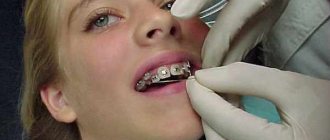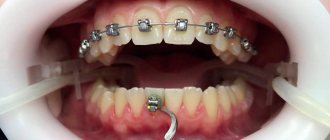People around you start to envy you kindly
Not many people can boast of a perfect smile, but only a few take on this problem. However, braces on an adult are causing others to think about going to the dentist again. Yes, people around you will pay attention to you more often; friends and acquaintances will begin to be interested in the details of the treatment, the sensations, and the cost of the design. One thing is for sure - they will respect you, because you care about your health and did what many do not dare to do. In addition, not everyone is ready to shell out more than 100 thousand rubles to correct their smile.
When to seek correction
Braces can be installed at almost any age, there are no restrictions. This means that people not only after 30, but also much older, can turn to dentists. However, correction for adolescents and adults has significant differences that should not be forgotten:
- preparation takes longer, in some cases it is necessary to remove several teeth to make room for movement;
- the duration of treatment is three to three and a half years;
- the movement of individual units occurs according to the dentoalveolar type;
- simultaneously with the orthodontic apparatus, it is possible to use additional structures that increase efficiency;
- to consolidate the result, you need to wear a retention mouthguard or other device;
- The period of wearing a retainer is long, for some Patients it will be lifelong (a rare situation, but possible).
The optimal age for correcting malocclusion pathologies is 15-20 years. At this time, the bones are mobile and respond well to external influences. But after 30, the process slows down, and correcting occlusion problems is more difficult to solve. Therefore, when choosing tools for treatment, more factors need to be taken into account. This is not only the state of tissues, but also health. Indications for installation of an orthodontic appliance are:
- partial adentia at an early age;
- the neck of the tooth is exposed;
- severe abrasion of enamel;
- problems in the temporomandibular joint;
- caries affecting multiple areas;
- periodontitis;
- chips, cracks and other damage to hard tissues due to improper position of teeth;
- pain in the neck, back, head;
- violations of respiratory and chewing function;
- facial asymmetry;
- problems with diction due to jaw growth abnormalities;
- Gastrointestinal diseases caused by impaired chewing of food.
If treatment is refused, many complications are likely to develop, including complete adentia and the need for costly surgical correction of pathologies in the future.
Reaching a new goal
Perhaps you are faced with a difficult choice: on the one hand, you are embarrassed about your smile, on the other, you do not want to wear braces for 1 to 3 years. But the faster you start, the faster you finish. As they say, the best time to do this is yesterday, the second best time is today. Moreover, you will experience great joy as you systematically move towards your goal, seeing how your teeth are straightened month after month, and in the end you will get the long-awaited result - a beautiful smile. This experience will certainly be useful in other areas of life.
Braces at 30-40 years old: is it too late?
We can safely say that braces are suitable for all ages: the orthodontic system corrects the bite no matter how old the patient is. There are no medical contraindications for this indicator: braces at 40 solve the same bite problems as braces at 30, and even at 14! And the difficulties associated with caring for the orthodontic system remain the same
Many adults come to correct their bite, understanding the functional need for bite correction, as well as the impact of appearance and smile on their own psychological health or the reaction of others. If a person is aesthetically or physiologically uncomfortable with an incorrect bite, getting braces at the age of 30 is simply necessary and not too late. It’s not too late to smile and be healthy and beautiful at this age, is it?
Age nuances
Of course, there are nuances. The condition of the musculoskeletal system in an adult is more difficult to correct. And only a specialist will advise which system of braces is more effective to use after 30. With age, the period of wearing braces may increase - at 40 years old you will have to wear them longer than at 14. But an adult approaches this issue more consciously: he understands the importance of correct hygienic care, financially wealthy and, in the end, it is not his parents who make the decision for him.
All this means that he can install not only the metal braces system that is usually chosen for teenagers. He has a wide choice: sapphire or gold, vestibular or lingual, ligature or self-ligating like Damon - any! Of course, the degree of bite pathology should also be taken into account here: the question of whether the bracket system you like is suitable for you can only be answered by an orthodontist after a thorough examination.
Some difficulties
You may need to prepare your mouth in a special way before installing braces after 30 or 40 years of age. It may be necessary to remove some teeth. Unfortunately, as an adult, there is no other way to find room in the mouth for teeth to move toward the correct bite. This is an objective reality, and not a doctor’s whim: surgical intervention will be recommended to you only if you are absolutely sure of improving the overall appearance of your smile and functional improvements in the maxillodentition.
In general, getting braces after age 30 will require patience and proper motivation from the patient. But the comfort and self-confidence after the result will many times exceed the difficulties that will have to be overcome!
Expert opinion
Orthodontics in Russia has become more active relatively recently, and it must be said that it has matured very quickly. Today, parents want to see the correct bite not only in their children, but also in themselves! And this is very correct. Braces in patients over 30 and 40 years of age are quite common throughout the civilized world. There are no age restrictions for installing braces. And adults have no more difficulties in servicing them than teenagers. If it so happens that your bite correction was not done during the period of growth of the body, then this is not at all a reason for frustration and, even more so, despair. Everything can change for the better right now!
Gum recession
Gum recession or exposure of the neck of the tooth root is a fairly common problem in orthodontic treatment. For example, treating severe crowding without extraction can lead to gum recession. The dentition expands and enlarges, but the bone base remains unchanged. In this case, partial or, in particularly difficult cases, complete exposure of the tooth root is possible. The contour of the gum changes, the teeth become visually longer. Sensitivity of teeth appears, reaction to sour, sweet, cold, hot. In addition to poorly planned orthodontic treatment, gum recession is caused by poor dental hygiene, tartar, and subgingival deposits. Therefore, when correcting a bite with braces, I recommend performing professional AirFlow hygiene at least three times during the entire treatment period. Before installing braces, in the middle of treatment and after removing the system. In addition, before starting to correct the bite, I teach personal hygiene while wearing braces and consider the patient’s compliance with the rules of dental hygiene to be a fundamental point in the prevention of possible oral diseases. Gum recession is fixable. The most common and reliable treatment for recession is surgery or gum grafting. And to be absolutely precise - the lateral flap method. A flap of healthy tissue is taken from the gum or hard palate adjacent to the affected area and sutured to the site of recession. The operation is performed under local anesthesia. Safe and relatively painless. The patient may experience tolerable discomfort in the area of intervention for a short time, but due to the fact that the tissues are completely identical, healing proceeds quickly and without complications.
What are braces?
Braces are special structures for each jaw, which consist of an arch and small clasps. The locks are attached to the arch and each tooth, gradually returning it to the correct position. All patients usually feel apprehensive when they understand what braces are. It seems that the arches and clasps will greatly interfere with eating and speaking and can injure the oral cavity. Discomfort is really felt, but after 1-2 weeks absolutely everyone gets used to the structure on their teeth and stops noticing it.
We are often asked the question: is it possible to put braces on one jaw without correcting the other? Alas, it’s impossible. It is important to understand that changing the position of the teeth affects not only the local area of \u200b\u200bbone tissue, but also the entire jaw. Therefore, the structures are placed on both in order to evenly correct the existing imbalance.
The most difficult and scary thing is only the first step - to make up your mind and get braces. After this, the 1–2 years that will be required for treatment will pass in the patient’s usual rhythm and with virtually no dietary restrictions. You will need to be a little more careful in choosing food and brushing your teeth. Otherwise, no difficulties will arise.
Braces in adults
The most favorable age range for correcting malocclusion is 12-18 years. During this period, all permanent teeth have already erupted, but the active growth phase continues. It is generally accepted that up to the age of 18, orthodontic treatment will take a minimum of time and be most effective. But it is not so. In many ways, the successful outcome of treatment and the time it takes to correct the bite depend on the patient: how responsibly he approaches the process, follows the recommendations of the orthodontist, and makes regular visits to the clinic. Adults are more scrupulous in this matter compared to teenagers, so wearing braces also brings the desired result.
Bite correction in adulthood is often indicated for patients not only for aesthetic reasons, although the desire to get a beautiful smile is in most cases the main reason for visiting an orthodontist. In addition to dissatisfaction with appearance and self-doubt, malocclusion often causes health problems: pain in the jaw, abrasion of enamel, gastrointestinal diseases due to poor chewing of food, headaches due to compression of joints and nerve endings.
So is it necessary to get braces? In 95% of cases the answer is “Yes!” The exception is contraindications and individual patient characteristics, which we will talk about later. All that remains is to dispel your basic fears and take a step towards a beautiful smile!
Cons of braces
The disadvantages of braces are as follows:
1. External braces are visible. Even if you choose sapphire or ceramic braces as the most aesthetic options, they are still visible to others. This is a conditional minus, since today braces are not perceived as a cosmetic defect, they rather emphasize the fact that a person cares about the beauty and health of his smile. But many are confused by the visibility of orthodontic structures, especially for those whose work involves constant communication with people and external attractiveness is of great importance. However, there are lingual braces that are installed from the inside and will not be visible to others. This solution has contraindications, but you can ask your doctor if it is possible to install an invisible braces system.
2. Particularly careful hygiene is required. The presence of fixed structures always requires attention to oral hygiene, because they contribute to the formation of a large amount of plaque. Plaque leads to tooth decay, caries, and the formation of tartar, so you need to get rid of it with the help of special brushes. Patients with braces should have their teeth professionally cleaned at least three times a year. Many are tired of having to constantly brush their teeth after eating; patients also note the impossibility of a normal visit to a cafe (they have to take brushes with them or go home immediately after for hygiene procedures).
3. Injuries to the mucous membranes of the lips, cheeks, and tongue. Any braces rub the mucous membranes, especially at first. There is a way to deal with this - special wax, which is used to seal areas of the structure that injure the tissue. And the big disadvantage of braces is that you have to deal with injury prevention.
4. Strict restrictions on diet. Doctors categorically do not recommend eating solid foods, nuts, and also prohibiting the consumption of viscous, sticky foods. Otherwise, there is a high risk of braces breaking, which will lead to an increase in treatment time.
TOP 5 fears of patients
Let's look at the main fears that make patients doubt whether to put braces on their jaw. Some of them are partly justified, some are not.
- For a long time. Yes, correcting a bite is not quick; treatment in adulthood takes an average of 1.5-2 years. But the result is worth it! Already in the first few months you will notice positive changes that will brighten up the period of wearing braces. Be a little patient, soon your dream of a beautiful smile will become a reality, and the question of whether you need to get braces will no longer be relevant!
- Noticeable. Most often, this question is relevant for girls and worries more than painful sensations when wearing. For patients who are concerned about the aesthetics of their smile, less noticeable systems have been developed - ceramic and sapphire braces, which are not so noticeable compared to standard metal ones. There are also invisible lingual braces that are attached to the back of the teeth, so the visual component is not a problem.
- Hurt. Unpleasant sensations while wearing braces are possible, but they are typical only for certain periods. Firstly, installing braces and getting used to them for the first 1-2 weeks. Secondly, correction of braces, which will be performed by an orthodontist approximately every 4-8 weeks. During the rest of the period after getting used to it, the structures will be almost not felt.
- Difficult to care for. During the period of wearing orthodontic systems, you will need to give up certain foods and drinks, and also pay special attention to oral hygiene. Yes, this is more labor-intensive than simply brushing your teeth, but patients quickly get used to this process, and it no longer causes as much discomfort as it might seem at the first stage.
- There will be no result. If you choose a competent orthodontist and follow all his recommendations, you will definitely get a beautiful, even smile as a result. Yes, this path requires time and effort, but it is better to decide and do it than to spend your whole life thinking about how to correct crooked teeth.
Cons and contraindications
We have already partially written about the disadvantages of brace systems above. All of them are not so significant as to make you doubt whether to put braces on your jaw. The main ones include possible damage to the enamel, complicated oral care, time and cost of treatment.
In what cases can orthodontic treatment not be carried out? There are not many absolute contraindications: epilepsy, tuberculosis, HIV, developmental features. The rest are relative: the presence of untreated teeth and inflammatory processes in the oral cavity, severe tooth wear, some diseases of the cardiovascular system, exceptional cases. The dentist will be able to accurately answer whether the bite needs to be corrected in your situation after examination and diagnosis.










